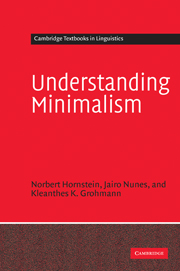Book contents
- Frontmatter
- Contents
- Preface
- List of abbreviations
- 1 The minimalist project
- 2 Some architectural issues in a minimalist setting
- 3 Theta domains
- 4 Case domains
- 5 Movement and minimality effects
- 6 Phrase structure
- 7 Linearization
- 8 Binding Theory
- 9 Feature interpretability and feature checking
- 10 Derivational economy
- Glossary of minimalist definitions
- References
- Language index
- Name index
- Subject index
8 - Binding Theory
Published online by Cambridge University Press: 05 June 2012
- Frontmatter
- Contents
- Preface
- List of abbreviations
- 1 The minimalist project
- 2 Some architectural issues in a minimalist setting
- 3 Theta domains
- 4 Case domains
- 5 Movement and minimality effects
- 6 Phrase structure
- 7 Linearization
- 8 Binding Theory
- 9 Feature interpretability and feature checking
- 10 Derivational economy
- Glossary of minimalist definitions
- References
- Language index
- Name index
- Subject index
Summary
Introduction
Chapters (6) and (7) considered some empirical and methodological reasons for treating movement as the combination of two simpler operations: Copy and Merge. So construing movement allowed us to eliminate traces as grammar-internal formatives (a methodological plus) and forced us to consider why the traces are phonetically null. According to the proposal discussed in chapter 7, if copies are not deleted in the phonological component, they may cause the derivation to crash at PF, as they induce contradicting linearization requirements (for instance, that a given syntactic object A must precede and be preceded by another syntactic object B).
We supported this reasoning empirically in two different ways. First, we observed that there are cases where what gets phonologically realized is not the antecedent of a trace but the trace itself. Second, we reviewed evidence suggesting that multiple copies can be pronounced if they are able to evade the conditions that force their deletion. Either case is not even a descriptive possibility if traces are defined as phonetically null, as is the case in GB-style accounts. By contrast, if traces are construed as copies, both cases can be properly handled, as we demonstrated in section 7.5.
This chapter considers binding theoretic evidence for the same conclusion, by exploring a suggestion made in section 6.4 regarding the interpretive properties of traces under the copy theory of movement. We'll see that the copy theory allows us to rebut empirical arguments for the postulation of DS and SS based on binding considerations.
- Type
- Chapter
- Information
- Understanding Minimalism , pp. 247 - 285Publisher: Cambridge University PressPrint publication year: 2005



